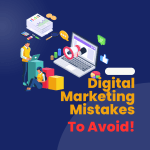
Embarking on a journey into the world of digital marketing can be both exciting and overwhelming. As a beginner, it’s crucial to navigate this dynamic field with caution and knowledge. To set you on the right path, we’ve compiled a comprehensive guide to the common digital marketing mistakes every beginner should be aware of.
Table of Contents
- Introduction
- Neglecting a Well-Defined Audience
- Disregarding the Power of SEO
- Underestimating the Value of Content
- Overlooking Mobile Optimization
- Ignoring Social Media Engagement
- Rushing Paid Advertising Campaigns
- Failing to Leverage Analytics
- Misusing Email Marketing
- Skipping Quality Over Quantity
- Neglecting Online Reputation Management
- Overlooking the Importance of Visuals
- Not Having a Consistent Brand Voice
- Disregarding Competition Analysis
- Underestimating the Power of Patience
- Conclusion
1. Introduction
As businesses shift their focus to the digital sphere, a strong digital marketing strategy is no longer a luxury but a necessity. However, many beginners stumble upon avoidable pitfalls that can hinder their success. Let’s delve into these mistakes and learn how to sidestep them effectively.
2. Neglecting a Well-Defined Audience
One of the gravest errors a beginner can commit is not identifying a target audience. Without a precise understanding of who your potential customers are, your efforts might go in vain. Crafting content and strategies tailored to your audience’s needs and preferences is the cornerstone of digital marketing success.
3. Disregarding the Power of SEO
Search Engine Optimization (SEO) is the driving force behind visibility in the vast online world. Ignoring SEO practices means your content might never reach your intended audience. Incorporating relevant keywords, optimizing meta descriptions, and improving website structure are pivotal for organic growth.
4. Underestimating the Value of Content
Content isn’t just king; it’s the kingdom. Overlooking the importance of high-quality, engaging content can hinder your digital marketing endeavors. Valuable content builds trust, authority, and loyalty among your audience, driving them to take desired actions.
5. Overlooking Mobile Optimization
In the era of smartphones, neglecting mobile optimization is a cardinal sin. A significant portion of online traffic comes from mobile devices. Failing to ensure a seamless mobile experience can lead to high bounce rates and lost opportunities.
6. Ignoring Social Media Engagement
Social media is a potent tool for brand exposure and engagement. Simply posting without actively engaging with your audience can hinder your progress. Responding to comments, messages, and creating shareable content can amplify your digital presence.
7. Rushing Paid Advertising Campaigns
While paid advertising can yield quick results, hasty campaigns without proper planning can drain your budget rapidly. Thoroughly research your target keywords, demographics, and create compelling ad copies to maximize your ROI.
8. Failing to Leverage Analytics
Digital marketing relies on data-driven insights. Neglecting analytics deprives you of the opportunity to measure the effectiveness of your strategies. Monitoring key metrics allows you to adjust your approach for optimal results.
Why Analytics Matter
Informed Decision-Making: Analytics empower you with data-driven insights that allow you to make informed decisions. Whether it’s adjusting your content strategy, refining your social media approach, or optimizing your website for better user experience, analytics provide the evidence you need to support your choices.
Understanding Audience Behavior: Through analytics, you can gain a deep understanding of how your audience interacts with your content. You can track metrics such as click-through rates, time spent on pages, bounce rates, and more. This data helps you tailor your content to better match your audience’s preferences, leading to higher engagement and conversions.
Identifying High-Performing Channels: Not all digital marketing channels yield the same results. Analytics help you identify which platforms and channels are driving the most traffic and conversions. This knowledge allows you to allocate your resources effectively and focus on the channels that deliver the best return on investment.
Measuring Campaign Effectiveness: Whether it’s an email campaign, a social media push, or a paid advertising campaign, analytics provide insights into their effectiveness. You can track metrics like open rates, click-through rates, and conversion rates to gauge how well your campaigns are performing and make necessary adjustments.
Key Analytics Metrics to Monitor
Traffic Sources: Identify where your website traffic is coming from – whether it’s organic search, social media, referrals, or direct visits. This helps you understand which channels are driving the most visitors.
Conversion Rates: Track the percentage of visitors who take a desired action, such as signing up for a newsletter, making a purchase, or filling out a contact form. This metric directly reflects the success of your campaigns.
Bounce Rate: Bounce rate indicates the percentage of visitors who leave your site without interacting with it. A high bounce rate could signal that your content isn’t resonating with your audience or that your website’s user experience needs improvement.
Time on Page: This metric reveals how much time visitors spend on each page of your website. Longer time on page usually indicates engaging content, while shorter durations might suggest that your content needs improvement.
Social Media Engagement: Monitor likes, shares, comments, and clicks on your social media posts. Engagement metrics provide insights into the type of content that resonates with your audience.
9. Misusing Email Marketing
Email marketing remains a potent tool, but bombarding your subscribers with irrelevant content can backfire. Personalize your email campaigns, segment your audience, and provide value to create a lasting impact.
Common Missteps in Email Marketing
Overloading Inboxes: Bombarding your subscribers with a barrage of emails can be counterproductive. It can lead to unsubscribes, high bounce rates, and your emails being marked as spam. Respect your audience’s inbox by sending relevant and valuable content at a reasonable frequency.
Generic Content: Sending generic, one-size-fits-all emails can result in disinterest. Personalization is key. Address subscribers by their names, tailor content to their preferences, and segment your email lists for more targeted messaging.
Lack of Value: Your emails should offer value to your subscribers. Whether it’s informative content, exclusive offers, or solutions to their pain points, make sure your emails provide something meaningful. Failing to offer value can lead to disengagement.
Ignoring Mobile Optimization: With a significant portion of emails being opened on mobile devices, neglecting mobile optimization is a grave mistake. Ensure that your emails are responsive and display correctly on various screen sizes.
Neglecting Subject Lines: Your email’s subject line is the first impression. Bland or misleading subject lines can result in your emails being ignored or deleted. Craft compelling subject lines that entice recipients to open your emails.
Best Practices for Effective Email Marketing
Segmentation: Divide your email list into segments based on factors like demographics, purchase history, and interests. This allows you to send targeted content that resonates with each group.
Personalization: Use subscriber data to personalize your emails. This can include addressing recipients by name, recommending products based on their previous purchases, and tailoring content to their preferences.
Clear Call to Action (CTA): Every email should have a clear and enticing CTA. Whether it’s to read an article, make a purchase, or download a resource, the CTA guides subscribers on their next steps.
Value-Oriented Content: Make sure each email provides value. Whether it’s educational content, special discounts, or entertaining stories, the content should enrich the subscriber’s experience.
Testing and Optimization: Continuously test different elements of your emails, such as subject lines, content layout, and CTAs. Analyze the results to optimize your future campaigns.
10. Skipping Quality Over Quantity
A common mistake is churning out a high volume of mediocre content. Focus on quality over quantity. Exceptional content resonates more with your audience and has a longer lifespan.
11. Neglecting Online Reputation Management
In the digital age, reputation can make or break a business. Overlooking online reputation management can result in negative reviews overshadowing your brand’s positive aspects. Monitor your online presence and address feedback promptly.
12. Overlooking the Importance of Visuals
Visual content has a profound impact on engagement. Neglecting visuals in your strategy can leave your content monotonous. Incorporate images, videos, and infographics to convey your message more effectively.
13. Not Having a Consistent Brand Voice
Inconsistency in your brand’s voice and messaging can confuse your audience. A unified brand voice across all platforms fosters recognition and builds a stronger connection with your customers.
14. Disregarding Competition Analysis
Analyzing your competitors provides valuable insights into their strategies and your unique selling points. Ignoring competition analysis can lead to missed opportunities for differentiation and innovation.
15. Underestimating the Power of Patience
Digital marketing is a long game. Expecting overnight success can lead to frustration. Patience is key as you wait for strategies to yield results and gain traction.
Conclusion
Embarking on a journey into digital marketing as a beginner is both challenging and rewarding. By avoiding these common mistakes and embracing strategic, data-driven approaches, you can set yourself up for success in the digital realm.
FAQs
Is SEO really that important for beginners? Absolutely. SEO forms the foundation of online visibility and organic growth.
How often should I post on social media? Focus on consistency rather than frequency. Quality content at a steady pace is more effective.
Can paid advertising work without a big budget? Yes, with careful planning. Start small and optimize your campaigns over time.
Why do I need to monitor analytics? Analytics provide insights into what’s working and what’s not, helping you refine your strategies.
How long until I see results from my efforts? Digital marketing results vary, but patience is key. It might take several months to see significant outcomes.









Leave a Comment
You must be logged in to post a comment